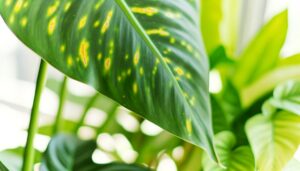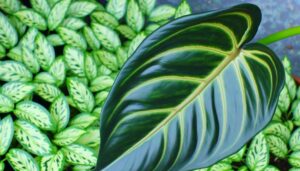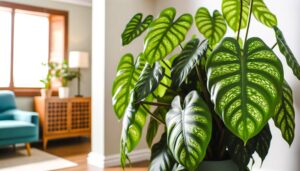What Are the Characteristics of Philodendron Verrucosum 'Esmeralda'?
Philodendron Verrucosum 'Esmeralda' features heart-shaped, velvety leaves with prominent venation, enhancing its visual and tactile appeal. It exhibits a vining growth habit, with aerial roots for anchoring and nutrient uptake.
The plant thrives in bright, indirect light, high humidity, and consistently moist soil. Ideal growth conditions include temperatures between 18-27°C (64-81°F) and humidity levels of 70-90%.
Common pests include spider mites, aphids, and mealybugs, with root rot as a notable disease. Regular monitoring and proper care are essential to maintain its health and beauty.
For a thorough understanding of its care requirements and growth patterns, additional details await.
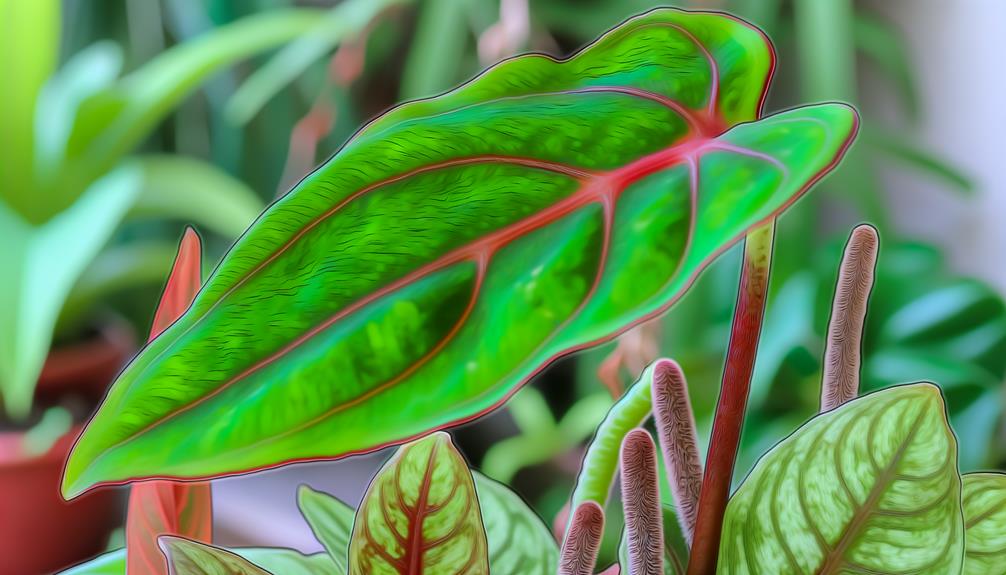
Key Takeaways
- Heart-shaped, velvety leaves with prominent veining create an aesthetically pleasing appearance.
- Unique, vividly colored vein patterns ensure efficient nutrient and water transport.
- Vining growth habit with aerial roots supports climbing and spreading.
- Thrives in bright, indirect light and high humidity environments.
- Requires consistent moisture levels while avoiding overwatering to prevent root rot.
Leaf Shape and Texture
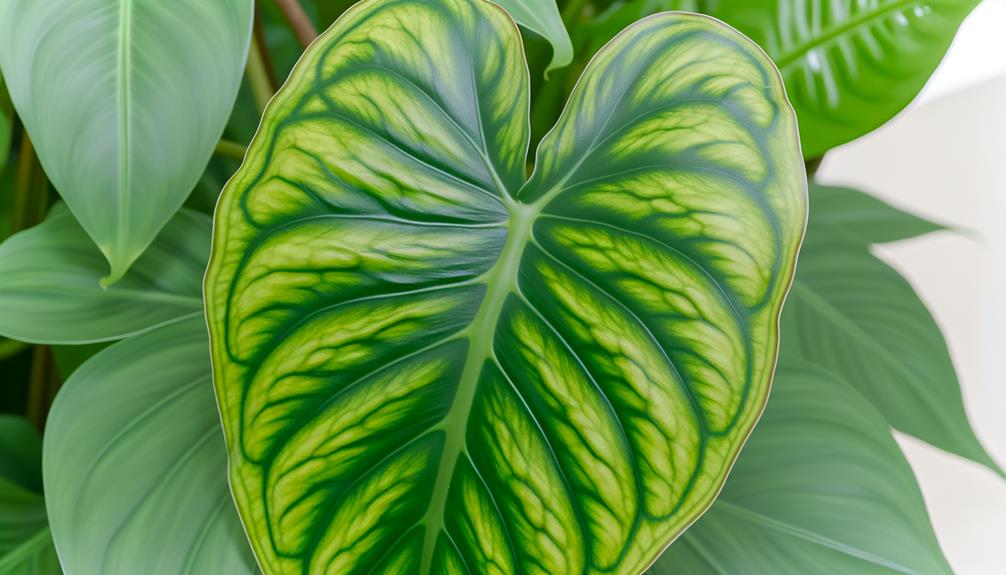
How does the Philodendron Verrucosum 'Esmeralda' captivate botanists and plant enthusiasts alike with its uniquely heart-shaped leaves that exhibit a velvety texture and prominent veining?
The allure lies in the leaves' distinct morphology and tactile qualities. Each leaf presents a broad, cordate shape with a finely tapered apex, creating an aesthetically pleasing symmetry.
The surface of the leaf is adorned with a velutinous layer, imparting a soft, velvet-like texture that enhances its visual appeal and sensory experience. This texture is not merely superficial; it plays a role in the plant's ability to manage water retention and light absorption.
The combination of the leaf's shape and texture makes the Philodendron Verrucosum 'Esmeralda' a subject of avid interest in both botanical study and ornamental gardening.
Unique Vein Patterns
Displaying a striking network of prominent veins, the Philodendron Verrucosum 'Esmeralda' exhibits a complex venation pattern that not only enhances its visual appeal but also serves important physiological functions.
The primary veins are deeply etched and vividly colored, often contrasting sharply with the dark green leaf blade. This intricate venation facilitates efficient nutrient and water transport throughout the leaf, optimizing photosynthesis and overall plant health.
The secondary and tertiary veins form a lattice-like structure, providing mechanical support and reducing the risk of tearing. The pattern is also indicative of the plant's adaptation to its native tropical environments, where robust vascular systems are essential for thriving in humid, low-light conditions.
Therefore, the vein patterns are both aesthetically and functionally significant.
Growth Habit
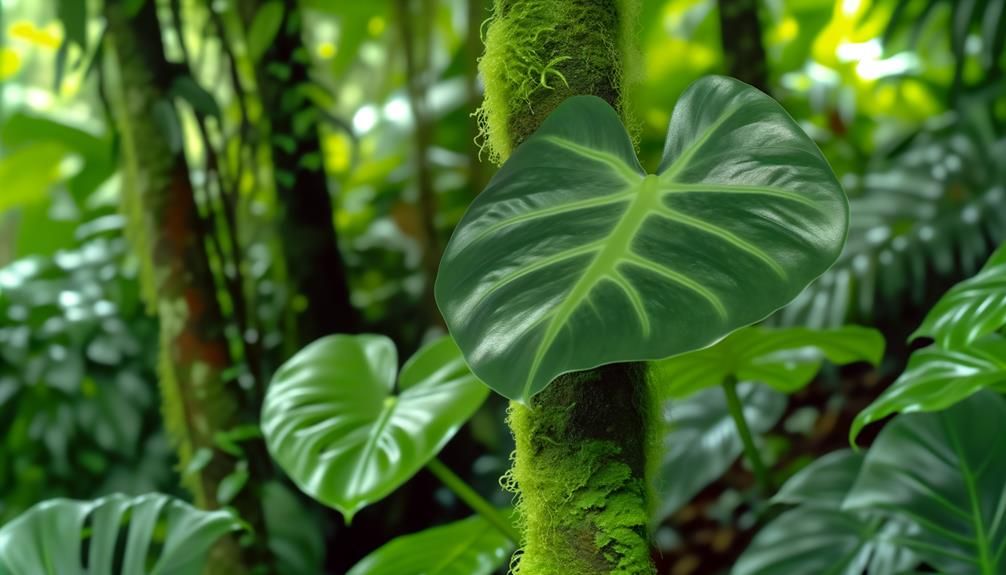
The Philodendron Verrucosum 'Esmeralda' demonstrates a vining growth habit, characterized by its ability to climb and spread across supports such as tree trunks or trellises, facilitated by its aerial roots. This epiphytic nature allows the plant to anchor itself securely to various surfaces, optimizing access to light and air.
The stems exhibit notable elongation, promoting extensive lateral spread and vertical growth. Internode spacing is variable but generally contributes to a lush, dense foliage display. Leaf nodes frequently produce adventitious roots, enabling effective nutrient uptake and further anchoring.
This growth habit not only supports its survival in natural habitats but also makes it an attractive specimen for indoor cultivation, where it can be trained for aesthetic appeal.
Light Requirements
Philodendron Verrucosum 'Esmeralda' thrives in bright, indirect light, which closely mimics the dappled sunlight filtering through the canopy in its native rainforest habitat. Best light conditions are essential for maintaining its vibrant, velvety foliage and promoting healthy growth.
Direct sunlight should be avoided as it can cause leaf burn and stress, compromising the plant's overall vigor. Conversely, insufficient light may lead to leggy growth and diminished leaf coloration. Utilizing sheer curtains or placing the plant near east or north-facing windows can provide the ideal lighting conditions.
Artificial grow lights with a spectrum mimicking natural sunlight can also be utilized, particularly in environments with lower natural light availability. Regular monitoring and adjustment of light exposure ensure optimal health and appearance.
Watering Needs
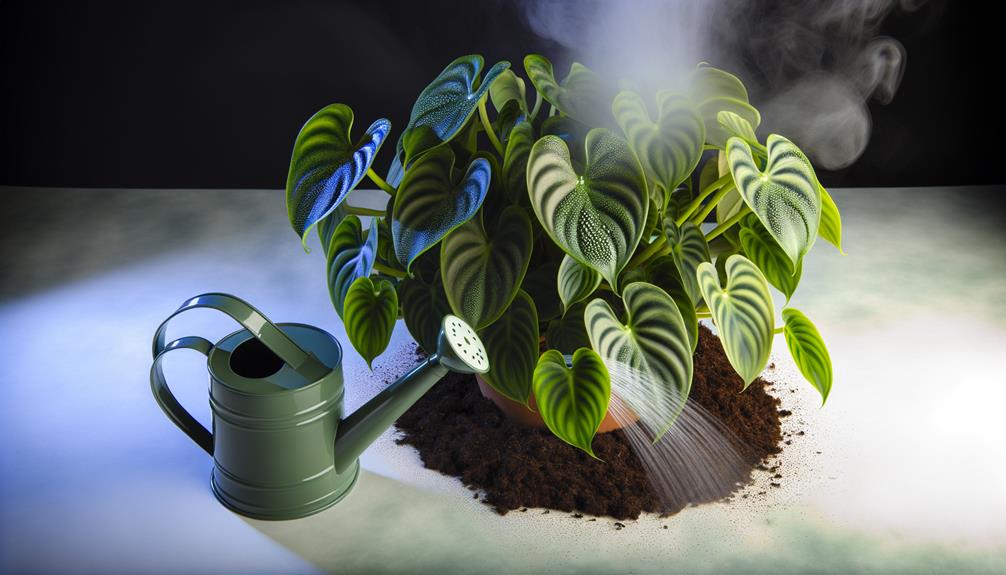
Consistent moisture levels are essential for maintaining the health and vigor of Philodendron Verrucosum 'Esmeralda,' requiring a careful balance to prevent both overwatering and underwatering. This tropical plant thrives in environments with high humidity, typically between 60-80%. Watering should be executed when the top inch of soil feels dry to the touch, ensuring that the potting medium remains evenly moist but not waterlogged.
Overwatering can lead to root rot, a common affliction in Philodendrons, while underwatering can cause leaf wilting and browning. Employing a well-draining pot and monitoring environmental humidity levels can significantly alleviate these risks. Utilizing tepid water and avoiding chlorinated water can further enhance the plant's overall health and growth.
Soil Preferences
Philodendron Verrucosum 'Esmeralda' flourishes in a well-aerated, organic-rich soil mix that closely mimics its natural habitat. The perfect soil composition should incorporate materials like peat moss, perlite, and orchid bark to guarantee top-notch nutrient availability and root support.
Moreover, adequate drainage is vital to avoid waterlogging and root rot, which can markedly affect plant health.
Proper Soil Composition
Perfect soil composition for Philodendron verrucosum 'Esmeralda' requires a well-draining, aerated medium that retains moisture without getting waterlogged. A suitable mix often includes a combination of organic and inorganic materials. Typically, a blend of peat moss or coconut coir, which provides moisture retention, mixed with perlite or coarse sand for aeration, is recommended.
Additionally, incorporating bark chips or horticultural charcoal can enhance drainage and prevent soil compaction. The organic components supply essential nutrients while promoting microbial activity, crucial for root health. Ensuring a pH range of 5.5 to 6.5 supports optimal nutrient uptake.
This balance of constituents creates an environment conducive to the plant's robust growth and overall essentiality.
Drainage Requirements
Ensuring proper drainage is essential in the soil preferences for Philodendron verrucosum 'Esmeralda', as it prevents root rot and other moisture-related issues. This species thrives in a well-aerated, porous medium that facilitates rapid water movement.
Best soil mixtures often incorporate components such as perlite, orchid bark, and sphagnum moss, which enhance drainage and air exchange. A high organic content is also optimal, promoting nutrient availability and microbial activity. The inclusion of coarse materials prevents soil compaction, ensuring roots have ample oxygen.
Regular monitoring of soil moisture levels, coupled with the use of containers possessing adequate drainage holes, further mitigates the risk of waterlogging, thereby fostering a healthy root system capable of supporting robust foliage growth.
Temperature and Humidity
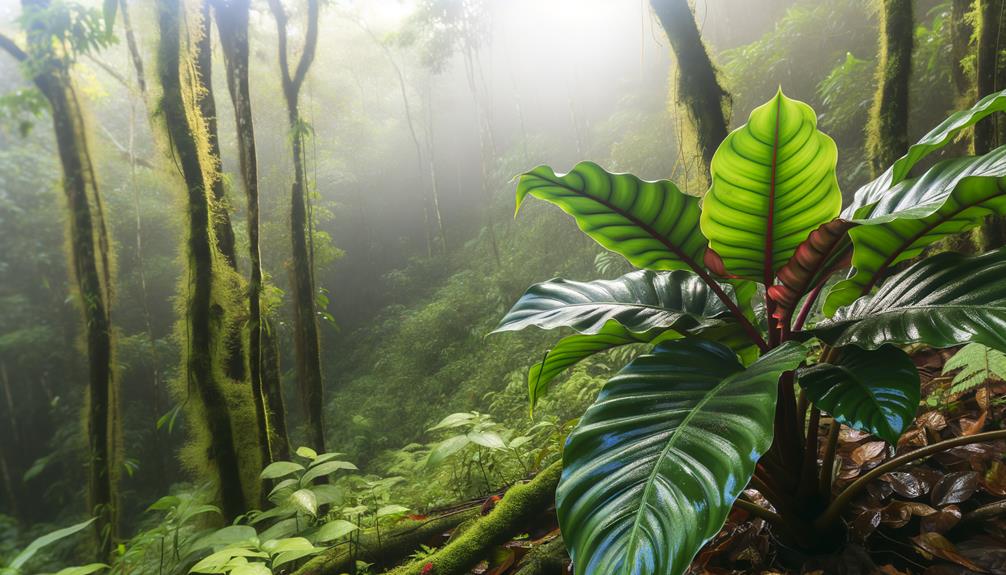
Philodendron Verrucosum 'Esmeralda' thrives in temperatures ranging from 18°C to 24°C, ensuring best metabolic and physiological processes.
This tropical species necessitates a high humidity level, ideally between 70% and 90%, to maintain its vibrant foliage and overall health.
Consistent environmental conditions are essential for preventing stress and promoting robust growth.
Optimal Growing Conditions
Maintaining ideal growing conditions for Philodendron Verrucosum 'Esmeralda' necessitates a consistent temperature range of 65-80°F (18-27°C) and high humidity levels of 70-90%. This tropical plant thrives in stable, warm environments, mimicking its native rainforest habitat.
Temperature fluctuations below 60°F (16°C) can impede growth and induce stress, while excessive heat above 85°F (29°C) can lead to dehydration and leaf damage. High humidity is pivotal, as it facilitates proper transpiration and nutrient uptake, preventing leaf browning and curling.
Utilizing humidifiers or placing the plant in naturally humid areas like bathrooms can achieve these conditions. Consistent monitoring and adjustments guarantee that Philodendron Verrucosum 'Esmeralda' maintains its lush, vibrant foliage and overall health.
Humidity Requirements
Achieving the exact moisture requirements for Philodendron Verrucosum 'Esmeralda' is crucial, as it entails maintaining ambient moisture levels between 70-90% to support most physiological processes. This high moisture range guarantees optimal stomatal function, transpiration rates, and overall cellular health.
Low moisture can lead to leaf desiccation, reduced growth, and increased vulnerability to pests. To reach these levels, use of a humidifier, regular misting, or placing the plant in a terrarium or greenhouse environment is recommended.
Additionally, ambient temperatures should be kept between 18-27°C (64-81°F) to complement moisture levels, avoiding significant fluctuations that can stress the plant. Monitoring with a hygrometer ensures accurate control, fostering ideal growing conditions for this tropical species.
Common Pests and Diseases
Despite its robust nature, Philodendron Verrucosum 'Esmeralda' is susceptible to various pests and diseases that can greatly impact its health and growth. Common pests include spider mites, aphids, and mealybugs, which feed on the plant's sap, causing yellowing and wilting of leaves. Regular inspection and the use of insecticidal soap or neem oil can manage these infestations.
Additionally, fungal infections such as root rot and leaf spot are prevalent in overly humid or poorly drained conditions. Root rot manifests as brown, mushy roots, while leaf spot presents as dark, water-soaked lesions. Ensuring proper watering practices and adequate air circulation can mitigate these issues.
Early detection and intervention are essential in maintaining the plant's vigor.
Conclusion
Philodendron verrucosum 'Esmeralda' showcases botanical intrigue through its heart-shaped leaves, intricate vein patterns, and unique texture.
The plant flourishes in bright, indirect light and needs consistently moist, well-draining soil. Best growth is attained in temperatures between 60-75°F with high humidity.
Importantly, research shows that maintaining humidity levels above 70% can notably improve leaf size and overall vigor.
Grasping these specific needs guarantees the successful cultivation of this enchanting species, adding to its popularity among tropical plant enthusiasts.


